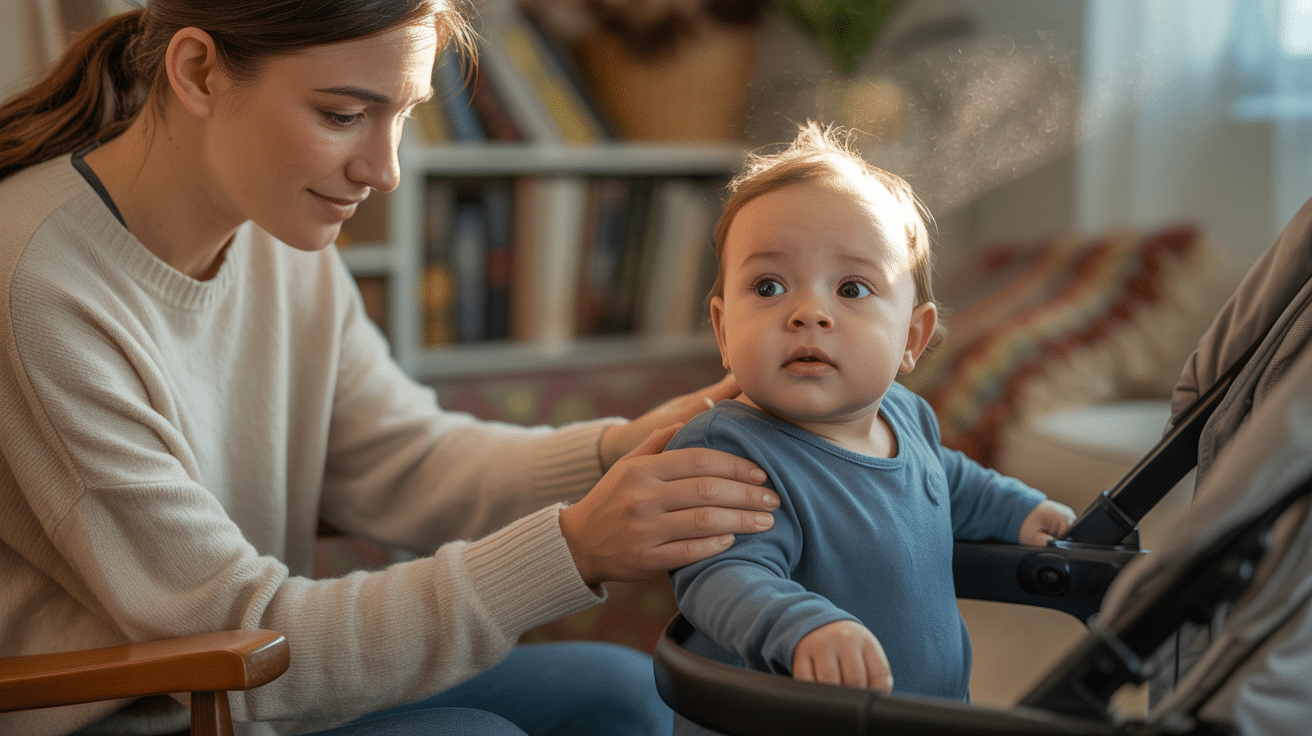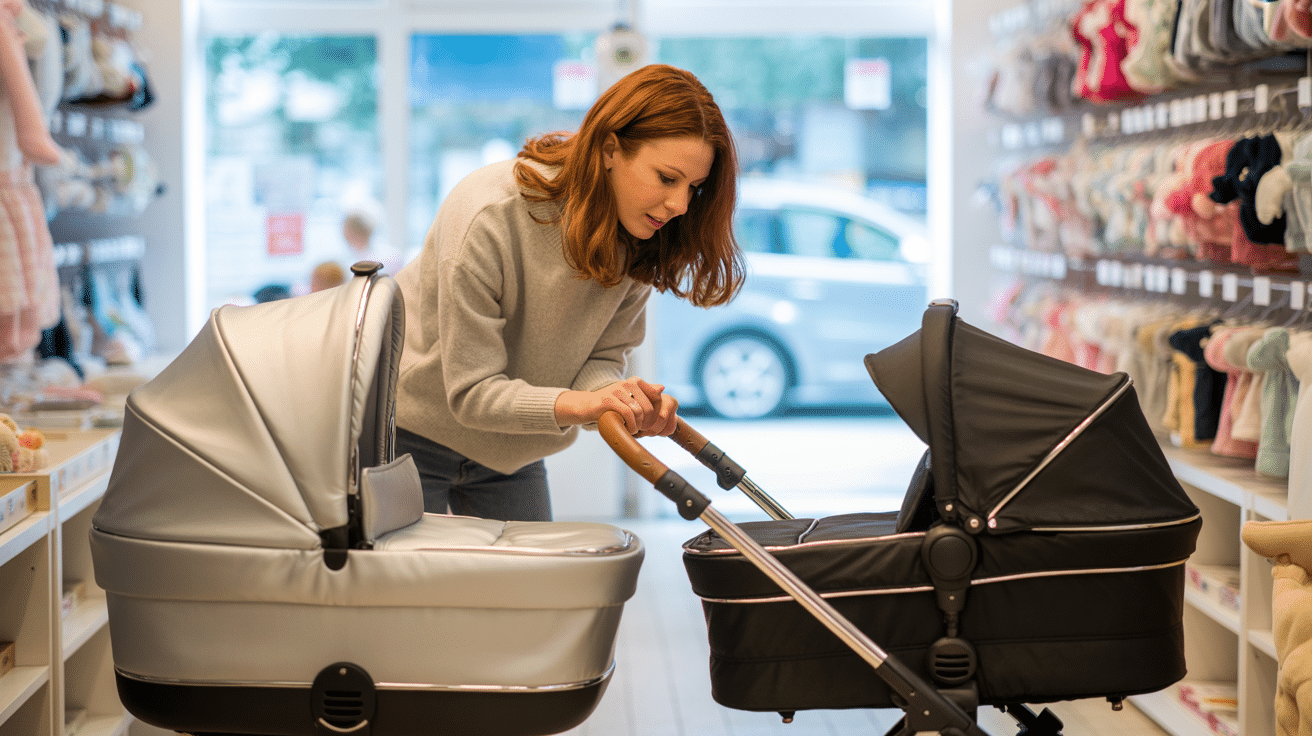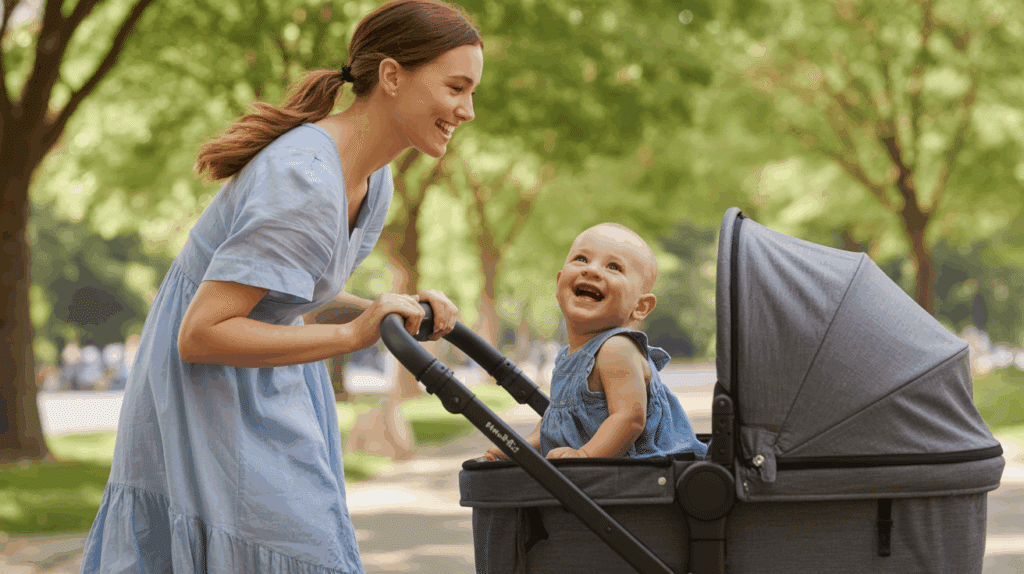Are you wondering when can baby sit in stroller? Many parents feel confused about the right time to make this switch.
This blog will show you how to spot when your baby is truly ready for stroller sitting time. You’ll also learn about the right types of strollers for each stage and simple tips to keep your baby safe and happy during rides.
Let’s help you make the best choice for your little one’s rides around town.
When Can Baby Sit in Stroller? Milestones to Look For

Most babies can start sitting in an upright stroller position between 4 to 6 months. But when can baby sit in stroller safely?
It depends more on their physical development than just their age. It’s important to watch for specific milestones that signal your baby is ready to safely sit in a regular stroller seat.
Instead of focusing only on their age, observe how your baby moves and holds themselves.
| Milestone | Typical Age Range | What to Look For |
|---|---|---|
| Gaining Head Control | 3–4 months | A baby can hold their head steady without wobbling when held upright |
| Sitting Up Unassisted | 4–7 months | Baby can sit without tipping over, even if only for short periods |
| Strong Neck & Back Muscles | 6–9 months | Baby shows stable control of the upper body when moved or placed in different positions |
Why Timing Matters: The Importance of Waiting Until Baby Is Ready
Putting your baby in a stroller before they’re physically ready can lead to problems. Babies need proper physical growth before sitting upright in strollers.
Waiting for the right physical signs means better outings with fewer worries for you and your baby. Here’s why timing matters:
- Physical support: Babies without full neck and back strength may slump to one side, causing strain on their growing spine and hips
- Comfort issues: Babies who can’t sit well often cry or fuss during stroller time because they feel unsteady
- Breathing concerns: Poor sitting position might cause your baby’s head to fall forward, potentially making breathing harder
- Safety risks: A baby who can’t sit steady might slip down in the seat, creating injury risks even with straps
- Happier outings: When your baby can sit well, they’ll enjoy looking around during walks, making trips more fun for everyone
How to Know If Baby Has Enough Head Control for a Stroller

When using a stroller, it’s important to ensure that your baby has developed enough head control for safety and comfort. Here’s how to tell if your baby is ready:
Head Stability:
Your baby should be able to lift their head and hold it steady when they’re sitting up. This typically happens around 4-6 months of age.
If your baby’s head wobbles or they have trouble keeping it up, they might not yet be ready for a stroller that requires good head control.
Strong Neck Muscles:
Babies need strong neck muscles to support their head while riding in a stroller.
If your baby can hold their head upright for a few moments when sitting, that’s a sign their neck muscles are getting stronger.
No More Head Lolling:
Babies who have enough head control won’t have their head lolling forward or sideways when in the stroller.
If you notice this, it may be time to consider waiting until their head control improves or using a stroller with better neck support.
Comfortable Sitting:
If your baby can sit upright for short periods without slumping or needing support, they likely have enough head control for stroller rides.
Some strollers also come with reclining features that can provide extra support if needed.
Check with Your Pediatrician:
Always consult your pediatrician if you’re unsure about whether your baby is ready for a stroller. They can give personalized advice based on your baby’s development.
By paying attention to these signs, you can make sure your baby is comfortable and safe while enjoying stroller rides!
When to Ask Your Doctor if Baby Is Ready for a Stroller
Some situations call for a chat with your baby’s doctor before using a stroller. This helps catch any issues early and keeps your baby safe.
If your baby still has wobbly head control by 4 months, mention this at their next check-up. This might point to muscles that need extra time to grow strong.
Babies with low muscle tone often need more time before sitting in strollers. Your doctor can check their strength and suggest helpful moves to build these muscles.
For babies born early, use their adjusted age (time since due date, not birth date) when thinking about stroller readiness. Their growth follows a different path.
If your baby slumps or seems upset in the stroller even after reaching key growth steps, ask your doctor about it. They might spot issues you missed.
Doctors can also give you tips for play that build the right muscles for good sitting.
How to Choose the Right Stroller for Your Baby

Finding the right stroller depends on your baby’s growth stage and your family needs. Each type serves different purposes as your baby grows.
Bassinet Strollers
These flat, bed-like strollers work best for newborns up to 6 months. They let babies lie completely flat, which helps their spine and breathing.
Look for models with good shade coverage and a firm, flat sleep surface. These are perfect for long walks when your baby needs to nap.
Travel Systems
These combine a car seat and stroller base. The car seat clicks onto the stroller, making moves from car to stroller smooth without waking your baby.
Most useful from birth until your baby can sit up (around 6 months). After that, you’ll use just the stroller part.
Upright Strollers
For babies with good sitting skills (usually 6+ months). These have more sitting options and often fold more easily. Look for five-point harnesses and multiple recline positions to match your baby’s needs as they grow.
Your daily life matters too. City parents might want lightweight, foldable models for public transit and small spaces.
Suburban families often prefer strollers with bigger storage and wheels. If you jog, wait until your baby is 6-9 months old and get a stroller made just for running with proper shock absorption.
Stroller Safety Tips Every Parent Should Know
Safety comes first when using any stroller with your baby. Even with the best model, you need to follow proper safety steps on every outing. When placing your baby in a stroller, always:
- Use the full harness system: Buckle all straps, including shoulder, waist, and crotch straps. The harness should be snug but not tight, with about one finger’s space between the straps and the baby.
- Stay close: Never walk away from a stroller with your baby inside, even for a moment. This prevents tipping, rolling, or overheating risks.
- Watch the weather: Use the canopy for sun protection and add a light blanket on cool days. Avoid stroller use in very hot weather when inside temperatures can rise quickly.
- Check stroller health: Look for any broken parts, loose wheels, or worn straps before each use. Store your stroller in a dry place to prevent rust or mold growth.
- Keep the stroller brake on: Always lock the wheels when you stop, even on flat ground.
Final Thoughts
Knowing when can baby sit in stroller depends mainly on their physical growth, not just their age.
The key signs, head control, sitting without help, and strong back muscles, tell you when they’re truly ready. Rushing this step can cause discomfort and even safety issues.
By following your baby’s natural growth cues rather than a calendar date, you’ll create better experiences for both of you. When your little one is ready, those neighborhood walks will become fun for everyone!
When did your baby start sitting upright in their stroller? Share your experience in the comments below!


















